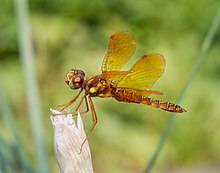| Eastern amberwing | |
|---|---|

| |
| Male | |
|
Scientific classification
| |
| Domain: | Eukaryota |
| Kingdom: | Animalia |
| Phylum: | Arthropoda |
| Class: | Insecta |
| Order: | Odonata |
| Infraorder: | Anisoptera |
| Family: | Libellulidae |
| Genus: | Perithemis |
| Species: | P. tenera
|
| Binomial name | |
| Perithemis tenera | |

| |
| Range of P. tenera [2] [3] | |
The eastern amberwing (Perithemis tenera) is a species of dragonfly in the family Libellulidae. It is very small, reaching a total length of no more than 25 millimetres (0.98 in). The males have orange or amber wings. Both sexes have a red pterostigma. [4]
The eastern amberwing dragonfly is one of the only types of dragonfly that actively mimics a wasp. The yellow and brown stripes on its abdomen encourage predators to stay away. When perched, they will wiggle their abdomen and wings in a wasp-like fashion to deter other animals from eating it. Males have an elaborate courtship ritual. When a female approaches his territory, the male will lead her to his selected egg-laying site and hover above it with wings whirring and abdomen raised. [5]
The common name refers to its eastern range, although this dragonfly does extend westward well into the central part of the United States. The scientific name, tenera, means delicate and alludes to its small size. [6]
Gallery
-
Male
-
Female
-
Ovipositing Naperville, USA
References
- ^ "Perithemis tenera". Integrated Taxonomic Information System.
- ^ "Perithemis tenera range map". USGS Northern Prairie Wildlife Research Center. Retrieved December 2, 2009.
- ^ "Distribution Viewer". OdonataCentral. Archived from the original on September 3, 2011. Retrieved December 2, 2009.
- ^ Abbott, John C. (2005). Dragonflies and Damselflies of Texas and the South-Central United States. Princeton University Press. pp. 292–293. ISBN 0-691-11364-5.
- ^ Silsby, Jill (2001). Dragonflies of the World. Csiro Publishing. p. 58. ISBN 978-0-643-10249-1.
- ^ Paulson, Dennis R.; Dunkle, Sidney W. (12 February 2021). "A Checklist of North American Odonata" (PDF). Jim Johnson. p. 73. Retrieved 26 July 2023 – via odonatacentral.org.
External links
-
 Media related to
Perithemis tenera at Wikimedia Commons
Media related to
Perithemis tenera at Wikimedia Commons - Perithemis tenera on BugGuide.Net
- Citizen science observations for Eastern amberwing at iNaturalist

